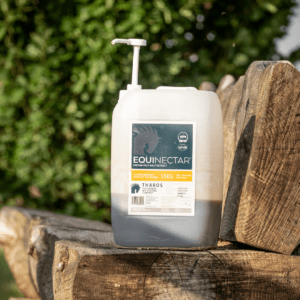What is fructanase?
Fructanase is an enzyme that breaks down fructans, which are complex sugars found in plants. Fructans are a type of polysaccharide, which are long chains of sugar molecules. Fructanase helps to break down these complex sugars into simpler sugars like glucose, which can be easily absorbed and utilised by the body (2).
In addition to its role in digestion, fructanase has significant industrial applications. It’s commonly used in the food industry to improve the digestibility of plant-based products. This can enhance the nutritional value of certain foods and potentially reduce digestive discomfort in consumers (1). In the realm of animal husbandry, fructanase is often added to animal feeds to improve the digestibility of forage and hay (3). This can be particularly beneficial for livestock, including horses, as it helps them extract more nutrients from their feed.
Can horses eat too many fructans?
Yes, horses can indeed eat too many fructans. Fructans are found in many plant-based feeds, such as forage and hay, and are an important source of energy for horses. However, consuming excessive amounts of fructans can lead to digestive issues and health problems (4).
When horses consume too many fructans, these complex sugars are fermented by bacteria in the hindgut, which can produce excess gas and cause digestive discomfort for the horse. This rapid fermentation can lead to a condition known as hindgut acidosis, where the pH in the hindgut becomes too low. This can damage the beneficial bacteria in the gut, potentially leading to more serious issues such as colic or laminitis in severe cases (4 & 6).
I’ve heard that grass contains fructans. Horses eat grass. Can this be problematic?
Yes, grass contains fructans, which can be problematic for horses if they consume excessive amounts. Fructans are complex sugars found in plants, and grass is a common source of fructans in a horse’s diet (4).
While horses have evolved to digest grass, modern pasture management and breeding practices have led to grasses with higher fructan content than what horses might encounter in the wild. Additionally, domesticated horses often have unrestricted access to grass, which can lead to overconsumption.
The fructan content in grass can vary significantly based on factors such as the time of day, season, and weather conditions (4). For instance, fructan levels tend to be higher in the spring and autumn, and during periods of stress such as drought or frost.
For some horses, particularly those prone to laminitis (6) or with metabolic issues, grazing on high-fructan grass can indeed be problematic (4). In these cases, grazing may need to be restricted or carefully managed to prevent health issues.
Cold nights and sunny days can lead to grass having high levels of fructans. How does this happen?
Cold nights and sunny days can lead to grass having high levels of fructans because these conditions are favourable for the production and accumulation of fructans in grass. Fructans are complex sugars found in plants, and they are produced by photosynthesis during the day (4). At night, when temperatures are cold, the plant’s metabolism slows down and the fructans are not used for energy. As a result, the fructans accumulate in the plant and can reach high levels in the grass. When the sun comes out again, the fructans continue to accumulate, leading to high levels in the grass.
This process is part of the plant’s natural defence mechanism against cold stress. The accumulated fructans act as a form of antifreeze, protecting the plant from damage during cold nights (5). However, this natural plant process can create challenges for horse owners, as the high fructan levels can potentially cause digestive issues in horses if consumed in large quantities.
It’s worth noting that fructan levels in grass can change rapidly (4). They’re typically lowest in the early morning and highest in the late afternoon, especially on sunny days following cold nights. This knowledge can be useful for horse owners in managing their horses’ grazing schedules.
How do horses produce fructanase?
Horses produce fructanase in their hindgut, which is the portion of the digestive system located after the small intestine (4 & 6). The hindgut, comprising the caecum and colon, is home to a diverse population of microorganisms, including bacteria, protozoa, and fungi. These microorganisms play a crucial role in the fermentation of plant material and the production of various enzymes, including fructanase (6).
The production of fructanase in horses is not a direct process carried out by the horse’s own cells, but rather a result of the symbiotic relationship between the horse and its gut microbiome (6). The microorganisms in the hindgut produce fructanase as part of their metabolic processes. This enzyme then helps break down the fructans present in the horse’s feed, allowing for better digestion and nutrient absorption (4 & 6).
How could supplementary fructanase help a horse’s digestion?
Supplementary fructanase can help a horse’s digestion by providing additional fructanase to break down the fructans it consumes in its diet. This can aid in the digestion of forage and hay, which are important sources of energy for horses (7).
By increasing the availability of fructanase in the digestive system, supplementary fructanase can potentially help break down fructans before they reach the hindgut (6 & 7). This could reduce the risk of rapid fermentation in the hindgut, which is associated with digestive discomfort and potential health issues.
Moreover, improved breakdown of fructans could lead to better overall nutrient absorption (3). As fructans are broken down into simpler sugars, these become more readily available for the horse’s body to use as energy.
For horses with sensitivities to fructans or those prone to conditions like laminitis, supplementary fructanase might help manage their condition by reducing the impact of fructans in their diet (6). However, it’s crucial to note that supplementation should always be done under veterinary guidance, as every horse’s nutritional needs are unique.
Can excess fructans upset a healthy microbiome?
Yes, excess fructans can upset a healthy microbiome. The microbiome is the community of bacteria and other microorganisms that live in the horse’s hindgut. Fructans are complex sugars found in plants, and they are fermented by bacteria in the hindgut (6). When a horse consumes excessive amounts of fructans, the bacteria in the hindgut can ferment the fructans, producing excess gas and leading to digestive discomfort for the horse (6). According to Heeringa (2024), this can upset the balance of the hindgut microbiome (6).
The rapid fermentation of excess fructans can lead to a condition called hindgut acidosis, where the pH in the hindgut becomes too low (8). This acidic environment can be harmful to many beneficial bacteria in the gut, potentially leading to a shift in the microbial population. Such changes in the microbiome can have far-reaching effects on the horse’s overall health, as the gut microbiome plays crucial roles in digestion, immune function, and even behaviour.
Could a fructanase supplement help maintain a healthy microbiome?
Yes, a fructanase supplement could help maintain a healthy microbiome. By aiding in the breakdown of fructans before they reach the hindgut, a fructanase supplement could potentially reduce the risk of rapid fermentation and the associated disruption to the microbiome.
When fructans are broken down into simpler sugars earlier in the digestive process, it reduces the amount of complex sugars reaching the hindgut (2). This can help prevent the rapid fermentation that can lead to hindgut acidosis and disturbances in the microbial balance (8).
Moreover, by promoting a more gradual and controlled fermentation process, a fructanase supplement could support a more stable environment for beneficial gut bacteria to thrive. This could potentially lead to a more diverse and resilient microbiome, which is generally associated with better overall health.
Does EquiNectar contain fructanase?
Yes. The fructanase within EquiNectar comes from the sprouting barley grain that is the key ingredient in EquiNectar. It is a natural source of fructanase.
Sprouting barley grain is known to be rich in various enzymes, including fructanase (9). During the sprouting process, the barley activates these enzymes as part of its natural growth cycle. By using sprouted barley as a key ingredient, EquiNectar provides a natural source of fructanase, rather than relying on artificially produced enzymes.
This natural approach to providing fructanase aligns with the principles of using whole-food based supplements in equine nutrition. The use of sprouted grains can potentially offer additional benefits beyond just the fructanase content, as sprouting can increase the bioavailability of various nutrients and potentially reduce certain antinutrients present in the unsprouted grain.
References:
[1] European Food Safety Authority. (2011). Scientific Opinion on the substantiation of health claims related to fructose and reduction of post-prandial glycaemic responses (ID 558) pursuant to Article 13(1) of Regulation (EC) No 1924/2006. https://www.efsa.europa.eu/en/efsajournal/pub/2223
[2] Dholariya, S. & Orrick, J. (2022). Biochemistry, Fructose Metabolism. Stat Pearls. https://www.ncbi.nlm.nih.gov/books/NBK576428/
[3] Seltzer, K., Hassen, A., Akanmu, A. & AZM, S. (2021). Digestibility and rumen fermentation of a high forage diet pre-treated with a mixture of cellulase and xylanase enzymes. South African Journal of Animal Science, 51(3), 1-8. https://www.researchgate.net/publication/352545972_Digestibility_and_rumen_fermentation_of_a_high_forage_diet_pre-treated_with_a_mixture_of_cellulase_and_xylanase_enzymes
[4] Kentucky Equine Research. (2020, April 28). Horses, Grass, and Fructans. Equine News.https://ker.com/equinews/horses-grass-and-fructans/
[5] Satyakam, Zinta, G., Singh, R. K., & Kumar, R. (2022). Cold adaptation strategies in plants-An emerging role of epigenetics and antifreeze proteins to engineer cold resilient plants. Frontiers in genetics, 13, 909007. https://doi.org/10.3389/fgene.2022.909007
[6] Heeringa, K. (2024, June 22). Fructans in Horse Forages: Do High-Fructan Grasses Cause Laminitis?. Madbarn. https://madbarn.com/fructans-in-horse-forages/
[7] Johnson, R. J., Rivard, C., Lanaspa, M. A., Otabachian-Smith, S., Ishimoto, T., Cicerchi, C., Cheeke, P. R., Macintosh, B., & Hess, T. (2013). Fructokinase, Fructans, Intestinal Permeability, and Metabolic Syndrome: An Equine Connection?. Journal of equine veterinary science, 33(2), 120–126. https://doi.org/10.1016/j.jevs.2012.05.004
[8] Davids, M. R., Segal, A. S., Brunengraber, H., & Halperin, M. L. (2004). An unusual cause for ketoacidosis. QJM .Monthly journal of the Association of Physicians, 97(6), 365–376. https://doi.org/10.1093/qjmed/hch064
[9] Mandl, E. (2020, July 9). What’s the Difference Between Barley and Wheat?. Healthline. https://www.healthline.com/nutrition/barley-vs-wheat





